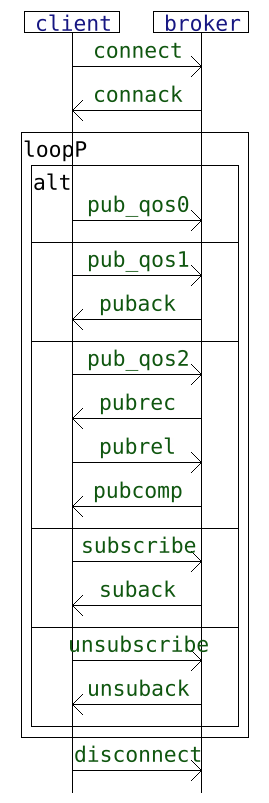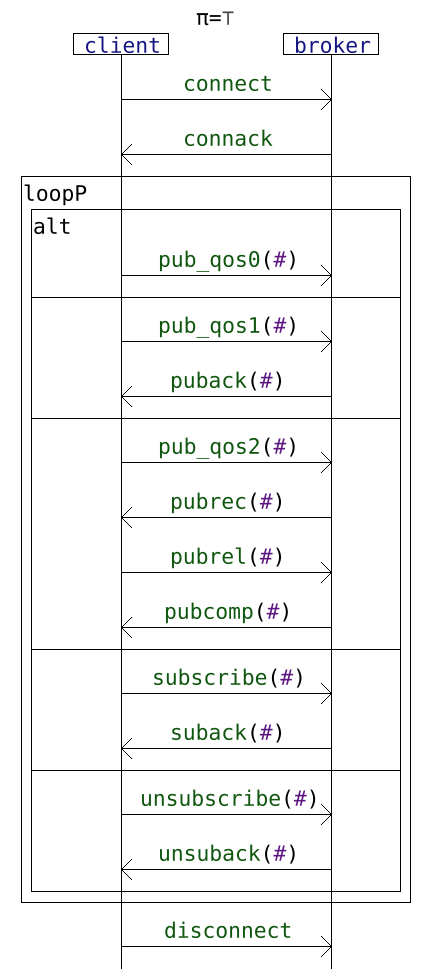This example is provided as an example aimed at explaining the advantage of considering value passing over the use of simple labelled messages.
See "hibou_label" and "hibou_efm" for the tools that are used.
We define an abstract "labelled" interaction model describing MQTT communications between a "client" and a "broker" as illustrated below. In that model, the loopP operator signifies that new instances of the loop can always be created and that every instance of the loop is executed concurrently w.r.t. all the other existing instances (in effect, new schemas/sessions of communications can always be opened and sessions that exist simultaneously are executed in parallel, reflecting the multi-threaded nature of the processes that run in both "client" and "broker").
We define a variant of that interaction model enriched with value passing as as illustrated below. The purple hashtag symbol roughly signifies that an unknown value is expected here each time a new instance of the message is emitted. In the context of MQTT the message argument that is modelled here is the unique message identifier (integer value).
We use a configurable multithreaded Python script to generate traces that could be obtained from an implementation of that client-broker system. The script generates correct traces and all the prefixes of those traces. It also generates mutants that correspond to the addition of an unexpected event at the end of each correct trace and of all its prefixes. Those mutant are, by construction, guaranteed to correspond to traces that are not accepted nor are they prefixes of accepted traces.
For each of those three kinds of traces (accepted, prefix and non-conform mutant), two variants are defined: (1) a "labelled" variant without typed parameters associated to the messages i.e. the MQTT messages that are exchanged are simple labels and (2) a variant "with data", with the unique MQTT message identifiers being taken into account when abstracting the exchanged information.
Then, the "labelled" traces are analyzed against the "labelled" interaction model and the traces "with data" are analyzed against the "symbolic" interaction model. Plotting the time of the analysis yields the following results:
The blue curve corresponds to the analysis of correct traces and their prefixes. The red curve corresponds to the analysis of non-conform mutants of various sizes.
We can see that, in the labelled case, there is an exponential increase in the time complexity when analyzing non-conform mutants, which is not the case in the symbolic case. We briefly explain the reason why in the following.
It suffices to consider the simple example below:
We can see that, given that the three instances of the reception event "l2?m1" are indistinguishable, the analysis must explore all possibilities so as to make sure that the trace is non-conform.
By contrast, when considering an interaction model enriched with data, the reception events "l2?m1(12)", "l2?m1(55)" and "l2?m1(76)" become distinguishable and the size of the graph that needs to be explored to prove non-conformance is reduced. This reduction in size is exponential with the number of successive emissions of "m1" which exactly mitigates the aformentioned exponential increase in the labelled case.

